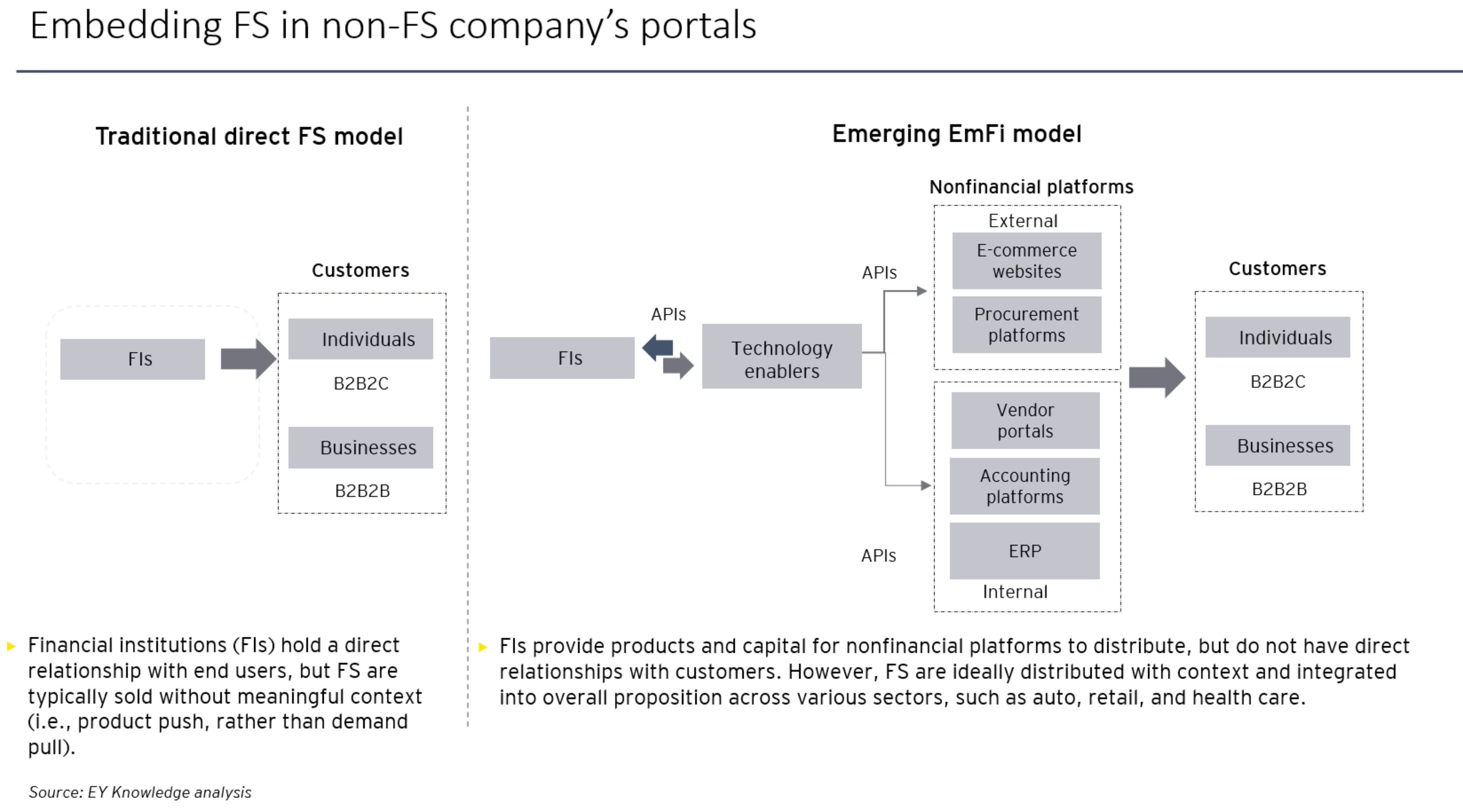
Chapter 1
The rise of EmFi and its role in SEA’s digital economy
Technology is fast-tracking innovation and is driving embedded finance and financial inclusion.
SEA, home to an estimated 400 million internet users in 2023, is one of the fastest-growing markets when it comes to digital device adoption and boasts among the most enthusiastic mobile app users globally. The region’s rapidly expanding population of tech-savvy individuals is fast-tracking digital innovation, with individuals and businesses there being among the most receptive towards FinTechs and novel ways of consuming FS vis-à-vis even peers within the more mature global markets.
SEA is also the headquarters to some of the world’s bigtechs that sit at the heart of digital business ecosystems. Several of these platform giants are expanding their beachheads into FS through the offering of “super apps” that enable users to access multiple services — ranging from e-commerce marketplaces to social media platforms, ride-hailing, food delivery, and online gaming — within an all-in-one mobile application. Such exponential growth in SEA’s digital ecosystem naturally lends itself to the rise of EmFi with customers increasingly wanting (and expecting) to avail financial solutions as part of a bigger digital bundle of services.
Equally significant is EmFi’s distinct role in promoting financial inclusion within emerging SEA markets such as Indonesia, the Philippines and Vietnam, where individuals and small businesses face multiple barriers to entry that hinder access to basic FS. For instance, the World Bank1 cites almost 49% of adults in Indonesia and the Philippines as not having formal bank accounts, double that of the global average of 24%. These unbanked populations represent crucial target markets for financial institutions (FIs), especially as their wealth and educational levels improve, and an increasing proportion of individuals and businesses become more upwardly mobile.
With today’s technological advances enabling more seamless integration of FS into nonfinancial platforms, reducing barriers to access, and lowering cost-to-serve through digital platforms, it has gotten more practical for financial providers to extend offerings such as digital wallets to these often-overlooked segments. Such payment options are instrumental in promoting financial inclusion and empowering more of SEA’s populations to participate in the digital economy.

Chapter 2
Opportunities that EmFi presents to ecosystem participants
The cross-industry collaboration results in win-win benefits for all market participants.
EmFi boasts diverse opportunities that span the entire FS ecosystem, empowering providers to seamlessly integrate into the value chain and deliver financial solutions at the point of need. This could see the FIs, tech enablers and platforms benefit from a flywheel effect as they collaborate to drive momentum that further enhances customers’ experiences, keeps them satisfied, and hence engaged and captive within that specific ecosystem. That in turn, enables providers to scale their product offerings vertically and acquire customers at a relatively low incremental cost — a win for all parties involved.
Here, we dive into the specific benefits of EmFi for each of these participants:
- Financial institutions: EmFi presents FIs with a unique opportunity to explore new markets and reinvent their core businesses by partnering with third-party platforms to offer interoperable FS. On the expense side of the equation, providing FS through embedded solutions within platforms enables FIs to simplify channel outreach with fewer distribution outlets and reduce acquisition cost per customer. Meanwhile on the revenue front, FIs can craft new income streams from enabling permissioned data access or getting their transaction revenue share from partners.
By keeping customers entrenched within the partner platforms, FIs not only expand customer connectivity but accumulate a plethora of data on a vast user base. This provides deeper analytical insights around customer behavior and preferences, thereby enabling them to offer personalized, context-aware financial solutions, while generating more granular risk profiling for individuals and businesses.
- Technology enablers and nonfinancial platforms: Non-FIs are already at the forefront when it comes to driving the EmFi revolution and can quickly integrate FS into their existing infrastructures and platforms. By providing the infrastructure and back-end functionality to incorporate EmFi solutions, tech providers benefit from recurring revenue streams. This initiative also enables them to develop adjacent services and explore cross-sell opportunities (for instance, a payment service provider may also offer a loan product to its customers).
For the platforms, having payments embedded in-app raises their conversion rates of individuals from browsers into customers, and enhances customer stickiness and retention from providing additional value-add along their journeys. More critically, EmFi facilitates non-FIs’ entry into a highly regulated FS market, and the opportunity to incorporate financial offerings into their portfolios without the encumbrances of being a regulated FIs themselves.
- Customers: With EmFi, individuals and businesses not only obtain easier access to FS and reduce their time spent researching and shortlisting, but access tailored offerings that are fit-for-purpose and based on their preferences and behavior, and perhaps even get these more competitively priced. Provider integrations that are done well also mean that users can conduct financial transactions effortlessly without switching between online merchants and FIs (or needing to seek credit elsewhere), leading to a more seamless and pleasant digital experience.

Chapter 3
Segmental applications to embed FS into the moment
With EmFi, nonfinancial platforms could offer payments, insurance, lending and wealth services.
The benefits of EmFi transcend FS, allowing for payments, insurance, lending, wealth investments, and other FS to be offered by non-FIs, in the context of everyday activities. EY teams estimate that the market size for global EmFi across the entire value chain will rise substantially from $264b in 2021 to touch $606b by 2025.

While such CAGR growth of 23% is already remarkable, what’s more interesting is the projection that APAC would account for $305b or circa 50% of that value in three years’ time. APAC (and specifically, the SEA markets) holds much promise for EmFi development given its young and aspiring population, rapid digital maturity and buzzing FinTech scene, and receptivity of customers to digital disruptors and new ways of consuming FS.
Below, we highlight the three most developed sub-segments within EmFi:
- Payments: We begin with embedded payments, estimated at 47% of the APAC EmFi market or $144b by 2025. Integration of the payments layer into the infrastructure of apps (such as ride-hailing platforms) or as digital wallets within merchant sites creates seamless fund flows, allowing end users to save a preferred payment method for future online purchases and subsequently pay at the click of a button.
This function enables digital players to facilitate a smooth checkout process and improve customer experiences, incorporate rewards systems to build customer loyalty and repeat purchases, and increase their share of payment commissions received.
- Insurance: Embedded insurance is potentially worth $83b or 27% of the APAC EmFi market by 2025. This weaves in premiums with products or services at the point of need, generating additional revenue streams for providers while concurrently offering end users the flexibility of natively embedded insurance at a reduced cost.
Insurance-as-a-Service is integrated with mobile apps and websites to purchase insurance with one click, removing the complexity of having to trawl through options from different providers. Applications include travel insurance (tagged to the purchase of a flight or train ticket), health insurance (e.g., as embedded offerings in HR platforms for employee coverage), equipment and electronic insurance, and vehicle insurance.
- Lending: Coming in a close third as one of the most promising categories of EmFi is embedded lending, projected by EY Teams at $78b in APAC by 2025. This features the integration of end-to-end credit products with a broader tech ecosystem or any e-commerce platform, enabling non-FIs to provide loans as a feature directly through their merchant sites, without necessitating a lending license.
The most pervasive form is buy now, pay later (BNPL), the seamless integration of an installment product into platforms of non-FIs such as retail merchants (through Point-Of-Sale machines) or marketplaces without routing to banks or other licensed debt providers. By providing access to short-term credit to fund the purchase of their own products, the frictionless user payment experience from BNPL helps merchants to reduce cart abandonment and accelerate sales. In emerging SEA markets where a high percentage of customers don’t have credit cards or cannot secure traditional credit and thus have limited access to financing, BNPL providers offer a financial lifeline. Their provision of low-friction, instant credit serves a valuable role in deepening financial inclusion.

Chapter 4
Implications to address
Regulatory, compatibility and integration challenges may prove more complex than anticipated.
While adoption of EmFi remains nascent, market observers are optimistic that this concept will mature quickly to revolutionize the way we access and use financial products. However, as ecosystem participants embrace this novel, agile model for offering interoperable FS — regulatory alignment, establishing of partnerships, and integrating systems and processes could prove more complex than anticipated.
Primary issues they should focus on include:
- Adherence to regulations: FS is among the most heavily regulated industries, so embedding financial offerings into nonfinancial platforms requires companies to carefully navigate complex regulations such as Know Your Customer (KYC), Anti-Money Laundering (AML), and data privacy laws. Compliance gets particularly challenging for non-FIs when dealing with multiple jurisdictions or when partnering with various financial providers, so close collaboration is essential to establish robust frameworks that foster innovation, meet industry-specific requirements, safeguard data ownership and use, and protect customers' interest.
Here, governments are taking steps to bring some EmFi elements within their regulatory ambit, with countries such as Singapore, Malaysia and Indonesia establishing frameworks for these activities. For instance, Singapore codified a set of explicit BNPL requirements to safeguard consumers against risks in November 2022, while Malaysia is currently seeking public feedback on its proposed Consumer Credit Act (CCA) to regulate non-bank credits providers including BNPL businesses.
- Maintenance of reputation and customer trust: Non-FIs entering the financial space may face skepticism and trust barriers from customers who are accustomed to engaging with traditional institutions and hesitant to share their financial data with non-FIs. Establishing credibility, building a strong brand reputation, and showcasing their platform’s security and reliability are crucial to build trust and overcome this mindset.
Meanwhile, though the FI partners typically white label their solutions and operate behind the scenes, their corporate brands are entwined with those of the non-FIs they collaborate with. By being associated with the nonfinancial platform, these FIs could also face corresponding trust issues should the nonfinancial entities within their ecosystem suffer reputational setbacks.
- Addressing integration complexities: Integrating FS into various platforms can be technically complex, particularly when dealing with multiple APIs, data formats, and legacy systems. Compatibility issues and the absence of standardized protocols for EmFi hinder interoperability between different platforms, resulting in fragmented user experiences, data silos, and operational inefficiencies. These require significant development effort and establishment of common frameworks for smoother integration and collaboration.
Beyond addressing compatibility challenges, these partners also need to structure clear agreements around:
- How risk is distributed, managed and mitigated within the integrated offering, particularly as risk profiles of FIs and non-FIs could differ significantly. For instance, embedding FS introduces new security risks and vulnerabilities, possibly exposing sensitive financial, transactional data and customers’ personal information files to unintended breaches, or fraud and identity theft.
- Data ownership and liability when financial data is shared between multiple parties, and how case of disputes or data breaches should be addressed.
- Revenue and profit-sharing models to avoid disputes and ensure a sustainable business strategy.
- Balancing different innovation pace, while maintaining reliably integrated EmFi offerings.
- Individual roles for customer support, and specific responsibilities for addressing user issues or handling disputes.
The onus lies on providers to collaborate and navigate such challenges to create a seamless and secure EmFi experience for customers, all the while safeguarding the stability of their financial ecosystem.
This article was authored with contributions from Li-May Chew, EY Global Banking & Capital Markets Senior Analyst — EY Knowledge.
Our related articles
Summary
Empowered by digital innovations, businesses and individuals are increasingly seeking financial solutions that are not only timely and transparent, but seamlessly accessible via their everyday activities. By integrating financial services into the value chains within the connected economy, embedded finance potentially makes access to financial solutions in the region more decentralized, personalized and inclusive, and unleashes immense opportunities for economic growth in Southeast Asia.



